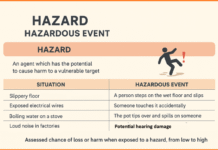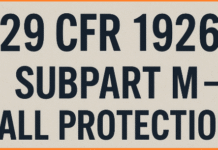Industrial processes involve use of chemicals and hazardous materials. Hence, safety considerations and control are highly warranted. The raw materials used in industries could be hazardous due to toxicity inherent to materials used in industries could be hazardous due to toxicity inherent to materials. The products both intermediate and finished as well as the
Contents
Hazardous substances can be broadly grouped as follows:
- Solid comprising of combustible/flammable solids, toxic and corrosive solids (including radioactive substance), solid causing spontaneous ignition or violent reactions(in presence of air or water), solid explosives or detonators.
- Liquid comprising of combustible/flammable liquids, toxic and corrosive liquids, liquids causing explosions.
- Gases comprising of combustible/flammable gases, toxic and corrosive gases, explosive gases or a mixture of gases which can cause explosion.
| Name of hazardous substance | example | Remarks/Effect |
| SOLIDS | ||
| Combustible/flammable | Wood, wool paper etc. | Catch fire easily and burn. |
| TOXIC solids | Certain compounds of lead, manganese, chromium, mercury, arsenic, cadmium. | Lead – poisoning Manganese- poisoning Chromium – poisoning Mercury – poisoning Arsenic- poisoning Cadmium- poisoning |
| Corrosive solid | Caustic soda, caustic potash | Causes blisters or burns. |
| Radioactive materials | Uranium, plutonium, thorium | Cause radiation hazards. |
| Spontaneous ignition or violent reactions | Sodium, lithium, phosphorus | |
| Explosives | Gunpowder, coal-dust | Causes explosions |
| Liquids | ||
| Combustible/ flammable liquids | Petrol, kerosene, methyl alcohol | Catch fire easily and burn. |
| Corrosive liquids | Nitric acid, sulphuric acid | Cause burn or blisters. |
| TOXIC liquid | Methyl alcohol, benzene, carbon tetrachloride, carbon disulphide | Cause poisoning |
| Explosive (liquid) | Nitro glycerine Tri Nitro Toluene | Cause explosion. |
| Gases | ||
| Combustible/ flammable gases | Oxygen, hydrogen acetylene | Cause fire easily/burn. |
| Corrosive gases | Sulphur dioxide, chlorine | Cause discomfort, corrosion, irritation. |
| Toxic gases | Carbon monoxide, methyl isocyanate, phosgene | Fatal in nature and cause death. |
| Explosives or form explosive mixture with air | Hydrogen, propane | Cause explosion |
Multiple effects of hazardous substances
The ill-effect of hazardous substances can be summarised as follows:
- Occupational diseases. Silicosis, asbestosis and a host of other occupational diseases are caused due to hazardous substances.
- Fire hazards.Combustible and flammable solids, liquids and gases cause fire hazards.
- Accidental release of toxic or corrosive chemicals. Toxic/corrosive materials can suddenly leak as a result of mechanical failure, inadvertence of mishandling on the part of workers thus causing serious accidents.
- Explosions. This may be caused due to accident arising out of explosives or explosive mixture due to bad storage of handling or spontaneous affects.
- Environment pollution. It may be caused due to inadequate or defective waste disposal or treatment methods.
Control measures
The following considerations are to be taken into account regarding control measures to contain the problems of hazardous substances in industries:
- Storage. Proper storage and handling specially that of materials in bulk or in large quantity need special care and attention. Haphazard storage and handling of hazardous materials can trigger off accidents.
- Temperature and pressure. Many processes or operations In industrial plant are associated with high temperature and pressure and pressure. In many such processes the reaction beings exothermic in nature in which unusual heat is unleashed. This may cause damage to equipment, systems and can trigger off fire hazards. Hence thorough control of temperature to permissible limits is one of the prime considerations. Similarly, unusual rise in pressure much above the stipulated or permissible limits may cause bursting of pipeline, failure of valves associated with leakage of hazardous substances. Suitable safety valves, a proper design of all assemblies pipeline system, pressure vessels etc. can check these maladies.
- Operations and processes. Any defect in design or any deviation from the design with respect to the various operations and processes may lead to serious consequences. Hence a proper design of the whole operational and process systems coupled with suitable follow up in the actual practice/ working is warranted. This implies that everything involved in the whole system (notably equipment, workmen work procedures, measuring instruments, the managers and the supervisors) must be functional. The failure of any one of the above components or units associated with the operations or process may lead to accidents.
- Educational and training. All the personnel involved in the industrial operations (specially the novices and new entrants) must be imbued with a sense of safety consciousness. This needs formal and informal education and training. In industries associated with hazardous chemicals, proper education and training must be imparted to the personnel regarding use of proper labels, warning sign and colour coded, proper methods of storage and handling etc. A harmonious relation between the workmen and the managers is necessary to synchronise the various activities of the persons concerned. Clear instructions, manuals or booklet for each hazardous job have to be supplied to the concerned workmen etc.
- Information, data collection and monitoring.Information and data collection and their subsequent analysis play a very important role. The identification of hazardous substances or their toxicity, the emergency requirement there in as well as proper handling and storage of these materials etc. are some of the information to be recorded in the safety data sheets. Suitable monitoring of hazardous substances can further bolster the safety measures and control.
- Repair and maintenance. Regular repair and maintenance as for example in the pipeline systems, valves, pressure, gauges etc. helps to minimise accidents. Extreme precautions are to be taken while repair and maintenance operations are being carried out, e.g., shut-downs during repairs etc. Any laxity, inadvertence or carelessness during repairs may create havoc.
- Personal protective equipment. All persons exposed to hazardous substances during manufacture, storage, handling etc. must be provided with personal protective equipment. This specially applies to novices, or new entrants who should be specially trained or instructed for the use of personal protective equipment.






Thanks for kind information